Wedding Etiquette
Here are some of the traditional guidelines of duties and decisions about your wedding. Remember: it's YOUR wedding - these are just starting points for you to understand, so you can address expectations, make agreements that work for everyone, plan details you might not have thought of, and create the wedding experience that YOU want.
|
Who Pays for What?
Unlike a decade ago, the lines are no longer rigidly drawn. Paying for the wedding has shifted in recent years from the shoulders of the father of the bride, to include the groom's family. Also, with many couples marrying later and having money of their own, they are sharing in the expenses. For second marriages, the bride & groom usually pay for everything on their own. Working out a budget for your wedding is one of the first things you should do, once the date is set. There are no longer any hard and fast rules as to "Who Pays for What", but here is a general guideline to the traditional breakdown. Traditional Breakdown of Expenses Engagement Ring for Bride - The Groom Wedding Ring for Bride - The Groom Wedding Gift for Bride - The Groom Groomsmen/Usher Gifts - The Groom Wedding Ring for Groom - The Bride Wedding Gift for Groom - The Bride Bridesmaid Gifts - The Bride Bride's Bouquet - The Groom Bridesmaid Bouquets - The Bride's Family Mothers' Corsages - The Groom Grandmother Corsages - The Bride's Family Groom's Boutonniere - The Groom Groomsmen Boutonnieres - The Groom Usher's Boutonnieres - The Groom Ceremony/Reception Flowers - The Bride's Family Canopy/Carpet/Kneeling Bench/Candleabra - The Bride's Family Rented Items for Ceremony or Reception - The Bride's Family Invitations/Announcements -The Bride's Family Wedding Programs - The Bride's Family Marriage License - The Groom Minister/Officiant Fee - The Groom Church Fee - The Bride's Family Musician/Soloist - The Bride's Family Church Janitor - The Bride's Family Reception Hall Fee - The Bride's Family Catered Reception/Professional Services - The Bride's Family Wedding Photography - The Bride's Family Video Photography - The Bride's Family Orchestra/Band/DJ - The Bride's Family Wedding Cake - The Bride's Family Groom's Cake - The Groom's Family Napkins/Matches/Printed Items - The Bride's Family Wedding Favors - The Bride's Family Rice Bags - The Bride's Family Rehearsal Dinner - The Groom's Family Bridesmaid Luncheon - The Bride Bachelor Party - Best Man/Groom's Attendants Bachelorette Party - Maid of Honor/Bride's Attendants Wedding Breakfast -The Bride's Family Bridal Brunch - The Bride's Family Wedding Gown, Headpiece & Accessories - The Bride's Family Bridesmaid's Gown - Bridesmaid Maid/Matron of Honor Gown - Maid/Matron of Honor Best Man Formal Wear - Best Man Ushers Formal Wear - Ushers Groomsmen's Formal Wear - Groomsmen Gloves/Ties/Ascots for Attendants - The Groom Father of Bride Formal Wear - Bride's Family Father of Groom Formal Wear - Groom's Family Children's Formal Wear - The Children's Parents Limousine Service- The Groom Honeymoon Arrangements - The Groom Travel Expenses to the Wedding - The Out-of-town Attendant or Family Member Accommodations for out-of town Guests - The Bride Here's a different list, grouped by Payee: Bride's Family
Bridesmaid/Maid of Honor
Groom's Family
Groomsmen
The Wedding Invitations
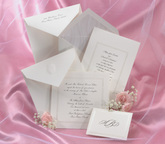
The core of a successful wedding invitation list needs to consist of people who know well, care about, and love the Bride and Groom. The bride-to-be and her mother should take into consideration the number of people who will fit comfortably into the reception area.
Wedding invitations are mailed to all those friends, relatives, and acquaintances who are invited to the ceremony. Your officiant & spouse get an invitation. Send invitations to your parents and wedding party as a keepsake. With regard to business associates, the invitation should be extended because of the friendship, not the business connection. For a home wedding, more discrimination is shown in the issuing of invitations. Intimate friends and relatives of both families are invited, but no casual acquaintances. The Invitation List for your Wedding It is necessary for the bride and groom to make out their guest list together. If the wedding is to be a large affair, the guest list will need to include not only their friends but the friends of their parents as well, along with business acquaintances of both families. If the wedding is a small one, great care should be taken lest the guests are so numerous as to overcrowd the church or home. Mailing the Wedding Invitation All wedding invitations should come from the home of the bride, even those that are for the personal friends of her husband (even if they are unknown to the bride.) They should be mailed about six weeks before the day set for the wedding. Out of town guests should be sent a "Save the Date" card, preferably with hotel suggestions, in time for them to make travel accommodations (usually 8-10 weeks in advance). Emily Post's Wedding Invitation Do's and Don'ts
Do's:
Wedding Tipping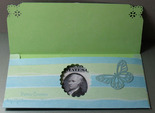
Tipping is a personal expression of gratitude for service given and appreciated. The question of tipping those persons responsible for assisting you in your wedding planning is one of obvious importance and concern.
Catering & Servers: Gratuities are almost always added into the final bill, whether you hire a private catering company or use one of the finest hotel facilities. The question has been asked, "Is it proper to tip the servers, when I have already paid a gratuity in my contracted price?" The answer is, of course, "tipping has always been a personal expression of gratitude for service given and appreciated." For instance, if a particular server spent his evening providing you service over and above your expectations, and you choose to give that individual a "tip," that choice is entirely up to you. It should be given for extra special services only. It is not required, as the gratuity has already been paid. The customary amount would be up to 15%. Others falling into the above category, include catering managers, hotel banquet managers, waiters, waitresses, bartenders, and bridal consultants. Tipping a hostess or captain would fall in the 1% to 2% range. Remember, this has already been added to your final bill and additional tipping is just that. Additional tipping! Coat Room Attendants: It is customary to give fifty cents per guest. However, it may be to your advantage to arrange for a flat fee prior to the event. Limousine Driver: A tip of 15% is the appropriate amount to be given to your limo driver. Be sure to read your contract, as the tip has often already been added into the final bill. Florists, Photographers, Bakers, Musicians: Tipping only for extra special services, up to 15%. Civil Ceremony Officials: (Judge, Justice of the Peace, City Clerk) In years gone by, it was considered improper to "ask" a set fee for services rendered. However, today, you may find a "suggested" donation for those in public service. In a recent survey, it was found the average gratuity was between $50 and $75. If travel is involved, an additional gratuity is expected. Ministers, Rabbis, Priests: Most officiants have a set fee for their services. In cases where clergy provide their services on a donation basis, no less than a $75 donation is considered proper and it is rare to find anyone giving less than a $100 gratuity to the wedding officiant. This donation should be given to the best man prior to the ceremony, and he will then give it to the officiant. If travel is involved, an additional gratuity is expected. Organist and Musician: Fees for church organist and musicians are sometimes included in the rental fee for the church. When this is not the case, in a recent survey, the average was $50 for each person. When the organist and musician (soloist) are close friends of the couple or family, the gratuity averaged $75. Other Festivities - who to invite
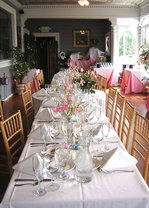
Engagement parties: Guests invited to the engagement party are also customarily invited to the wedding. For this reason, it's often best to limit the engagement party guest list, inviting only those you're sure will be invited to the wedding.
Showers: Close female friends and relatives of the bride, or, if it's a Jack and Jill shower, close friends and relatives of the bride and groom Bachelorette parties: Close female friend and family of the bride --usually those closer to her in age, though moms and aunts have been known to make appearances. If the gathering is co-ed, close friends and family of both the bride and groom are invited. General wedding-week parties: Anyone in town, of the bride and groom's choosing. Bridesmaids' party/groomsmen's dinner: The bride, her bridesmaids, and sometimes the mother; the groom, his groomsmen, and sometimes his dad. Rehearsal dinner: The parents & their spouses, siblings & their spouses, and any children of the bride and groom; their attendants; and the officiant. More guests, including other relatives, close friends, and out-of-town wedding guests can be invited at the discretion of the couple (and as budget allows). Reception: Usually, everyone who was invited to the wedding. If you choose to invite only a select group, be discreet when extending invitations. WHEN IT'S THE BRIDE'S SECOND MARRIAGE
If you've been married before or have children it's perfectly acceptable to wear white. If you've been married before or have children, you're not supposed to wear a veil or have a train attached to your dress or carry orange blossoms. (Must be a sign of purity or virginity thing). The second time around, your parents are not obligated to pay for anything. If you get along with your ex-husband and his family and it's fine with your fiancé, then it's acceptable to invite them to the wedding. IF YOU CANCEL OR POSTPONE THE WEDDING
TRADITIONAL CHRISTIAN CEREMONY
The wedding party should enter with men on the right and women on the left when walking down the aisle together. At the altar, the groom and groomsmen stand on the right side while the bride and her bridesmaids stand on the left, with the officiant positioned in the center. Right before the ceremony is about to begin, the parents of the groom and the mother of the bride should take their seats. The groom's parents can take their seats in the first row, on the right side. The mother of the bride, escorted by an usher or family member, can take her seat in the first row, on the left side. Her entrance officially marks the start of the processional. TRADITIONAL JEWISH CEREMONY For a Jewish ceremony, the wedding party should enter with men on the left and women on the right when walking down the aisle together. Beneath the chuppah (traditional Jewish wedding canopy), the groom and his parents stand on the left side while the bride and her parents stand on the right, with the rabbi and/or cantor in the center. Wedding-party members stand to the sides of the chuppah (groomsmen on the left, bridesmaids on the right) or they can be seated in the first row. |
Traditional Responsibilities of the Mother of the Groom
Traditional Responsibilities of the Mother of the Bride
The Primary responsibility of the Mother of the Bride is to see that the bride's wishes are carried out the bride's way. It will be your responsibility to help the bride plan her wedding with her tastes in mind…not yours, unless, it is the true desire of the bride to "let mom run things." Here are your primary responsibilities:
Maid of Honor's responsibilities
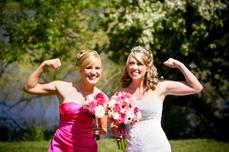
Best Man's responsibilities
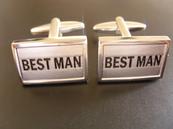
Duties & Responsibilities of Ushers/Groomsmen
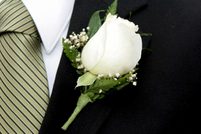
Ushers are to assist the bridal party. As a guideline, you need one wedding usher to every 50 guests. Wedding ushers direct guests to the appropriate places, ensuring the ceremony runs smoothly. Ushers may double as groomsmen.
The groomsmen and ushers are the first to arrive, around 30-45 minutes before the wedding ceremony. An usher may stand outside the church, greeting and directing the early guests to the appropriate seating and handing out programs or service notes and boutonnières for guests. - Groomsmen & ushers assist and take directions from the best man. - Usher & groomsman pays for his own attire. - Attends ceremony rehearsals. - Helps and assists the best man The Wedding Ceremony - At least one usher arrives at the wedding venue before the best man and groom. - He hands out any programs, service sheets, etc. - Making sure everything is in place and correctly set up. - At the ceremony, one usher waits outside giving advice. - Directs guests to their appropriate seating at the ceremony. - Informs the groom, the minister, and the musician when the bride is arriving. - Stays at the back of the ceremony to direct late guests. - May be required to slip out during the service for errands. - Usher number 2, heads to the reception in advance to check welcome drinks and all arrangements are in place. - Usher number 1 stays behind ensures everybody knows the way to the reception. At the Reception - Helps co-ordinates photographer and guests to be photographed. - Make sure all guests have a drink and someone to talk to. - Directs guests to cloakrooms and bathrooms. - Ensures wedding gifts are appropriately placed. - Ensures bride & groom's wedding car is ready and packed. - Reminds people to take all their belongings at the end of the evening. - Checks nothing has been forgotten or left behind. - May receive a gift from the groom. Seating the Guests
After the Ceremony
Corsages & Boutonnieres
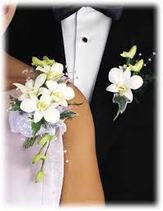
The bride and groom often acknowledge those closest to them by giving the men boutonnieres and the women corsages to wear to the festivities. Although there are no defined rules as to whom the couple must give these flowers to, most follow a similar practice.
Who Gets Boutonnieres Boutonnieres are typically worn by the Groom and both the bride and groom's fathers, stepfathers, and grandfathers, the ushers & groomsmen, the ring bearer, and any male participating in the wedding who is not being paid for his services. Other male immediate family members who are not in the wedding (brothers, uncles, etc) are also often given a boutonniere to wear. Do not give one to a man in full military dress. Sometimes a boutonniere is provided for the minister (but not if he wears a robe) or musicians. The groom's boutonniere usually stands out from the rest, by having a flower matching the bride's bouquet in it. Most couples find it easiest to make the rest of the boutonnieres match. The traditional color for wedding boutonniere flowers is white, but there is no wrong flower or color to use for it. It is worn on the left lapel, step down, over the lapel buttonhole. Who Gets Corsages Corsages are typically worn by the bride and groom's mothers, step-mothers, and grandmothers. They can also be given to any female guest of distinction, such as sister, aunt, daughter, or a dear friend who is not in the wedding party. Occasionally, they are given to wedding musicians. The mothers and stepmothers of the bride and groom usually have matching corsages that are different from the rest. THE DREADED RECEPTION SEATING PLAN
|


